When buying a property, you need to be sure that it meets certain requirements and standards, both personal and otherwise. One of the necessary standards that a real estate property should meet is environmental standards.

Before you decide on getting a property, you have to be sure of its environmental condition. This can be done through what is known as environmental due diligence. Landowners or those looking to buy lands can either choose to carry out desktop environmental reports or Phase I Environmental Site Assessments.
These two assessments are not to be confused with the other as they are different and carried out based on different circumstances. In this article, we will take a closer look at the two processes to help you get a clearer understanding of them.
Phase I Environmental Site Assessments
Phase I Environmental Site Assessment refers to the standard process involved in identifying existing or potential environmental contamination on a piece of land. This process is abbreviated as and commonly called ESA.
It has to be carried out before the purchase deal is closed. The main reason for this activity is to make sure that the land purchaser’s contamination risk and liability are limited.
Events That Triggers An ESA
An ESA can be triggered (that is required) for several reasons including:
1. When a Property is Being Bought or Sold
If you want to either sell or buy a property or even a business, you need to carry out due diligence to ensure that the property doesn’t have any past or current liability. This includes permits violations, enforcement deficiencies, and hazardous contaminations.
2. Transferring Real Estate To A Beneficiary After Retirement
Assuming you are about to retire and you wish to transfer your real estate to a beneficiary, the beneficiary would have to carry out an ESA on the property. This would make them assured that they aren’t liable to any liability.
3. When Refinancing a Property
Refinancing a property refers to the process of replacing a mortgage with a new loan. You can read this article to learn more about mortgage refinancing.
When you are refinancing your property, the loaner would ask that an ESA be done so that they can be sure of the property’s condition.
4. On Existing Owners Request
Someone that already owns a property can decide to carry out an ESA if they are interested in finding out the asset’s toxic history.
5. On the Request of a Regulatory Body
A regulatory body may suspect that a particular land has some toxic condition. In cases like this, the owner of the land may be ordered to do an ESA.
Desktop Environmental Report
These reports are limited versions of ESAs. They are used in cases where the property is considered low or moderate risk. In cases like these, a full ESA may not be necessary, and a limited report is done instead.
This limited report typically does not meet all the requirements of both the state and federal laws. This means they aren’t legally binding.
What It Includes
This report usually includes:
- Reviews of the historical records of the property including topo maps, building records, assessor records, historical aerials, and so on.
- A site plan draft
- Review groundwater conditions, depth, flow direction, and uses, so groundwater contamination may be detected. You can visit https://www.sciencedirect.com/ to learn more about groundwater contamination.
- Issue a report which contains recommendations and conclusions.
ESA Vs Desktop Environmental Report
So far, we have seen that these two processes are different in that while one is the full standard procedure, the other is merely a limited version of the other.
Plus, the limited version does not meet all of the Environmental Protection Agency’s regulations. They also do not meet both federal and state laws. Their scope is also quite limited and sometimes, some contaminants may go undetected during the process due to their limited scope.
Another thing that distinguishes both procedures is the protection they offer. The Comprehensive Environmental Response, Compensation, and Liability Act is used to decide the party that is liable for the contamination.
Through this Act, owners of lands where contaminants are found may be ordered to dispose of the toxic chemicals at their expense. Most times, it doesn’t matter if they are originally the ones to create the contamination.
However, a landowner can be considered a contagious property owner making them not liable for the contamination. Completing an ESA on the property before the purchase can qualify you as a contagious landowner.
However, because a desktop report doesn’t meet all of EPA’s requirements, it can’t provide landowners with this protection.
Conclusion
ESA is due diligence done on a piece of land to check for toxic contaminants. Desktop environmental report on the other hand is a limited version of an ESA. It typically doesn’t meet all the standard requirements that an ESA does. Hence, it is only used for properties that are considered to have lesser risk.
